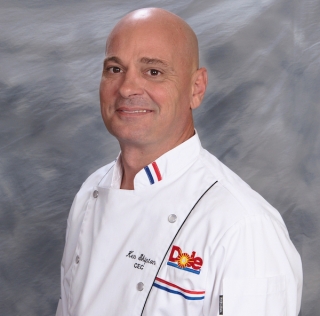
Healthcare Foodservice: A Different Culinary Career Path
28 March 2016An aging population and growing demand for healthcare facilities has lead to an increased need for culinarians to feed the seniors.
By Lisa Parrish, GMC Editor
Not all chefs work in restaurants. Healthcare and medical facilities constitute a growing area of employment opportunities for trained foodservice professionals.
According to the United States Census Bureau, in 2050 the population of people 65 years and over is projected to be 83.7 million, almost double its estimated population of 43.1 million in 2012. To be sure, in 38 years there will be 40 million more people 65 years and older.
DOLE Packaged Foods Corporate Chef Ken Shipton, CEC, is well aware of the growing need for culinarians in the healthcare industry. Before accepting his current position, he worked in the dining services area and administration of an assisted living facility in Florida. “Medical facilities and the healthcare industries are a growing area of employment choices for culinarians,” he said.
According to Chef Shipton, working with the geriatric population can be a very gratifying career. He explained people who move to facilities can lose much control over their day-to-day living decisions. For example, people are told when to take pills and how to move but they usually are not told what to eat. “Sometimes, a client’s only choice is what they have to eat. Food makes people happy and it was always rewarding to me to make the clients happy,” he said.
The current generation’s palate is more adventuresome than previous generations, according to Chef Shipton. “They bring these sophisticated palates to the facilities where they expect more than oatmeal for breakfast and meat and potatoes for dinner,” he said.
Another benefit of choosing a culinary career in healthcare over a restaurant is the consistency of the environment. “The hours are more set (in the healthcare arena),” Chef Shipton said. “You usually work around 40 hours per week and not the 70-plus hours found in a restaurant. Also, you know how many people you are feeding for a meal. This allows you to take more time with planning the meals.”
Finally, foodservice professionals can find a variety of healthcare environments to choose from with varied benefits. Chef Shipton explained, “You can work in a bare bones facility where you are allotted a certain amount of money to feed clients or choose a high-end facility that will do whatever the clients want to be satisfied. It’s a tremendous opportunity.”
There are many career opportunities available to culinarians looking for employment. The healthcare industry will continue to grow and require skilled chefs to feed this county’s aging population.
Photo courtesy of DOLE Packaged Foods.
